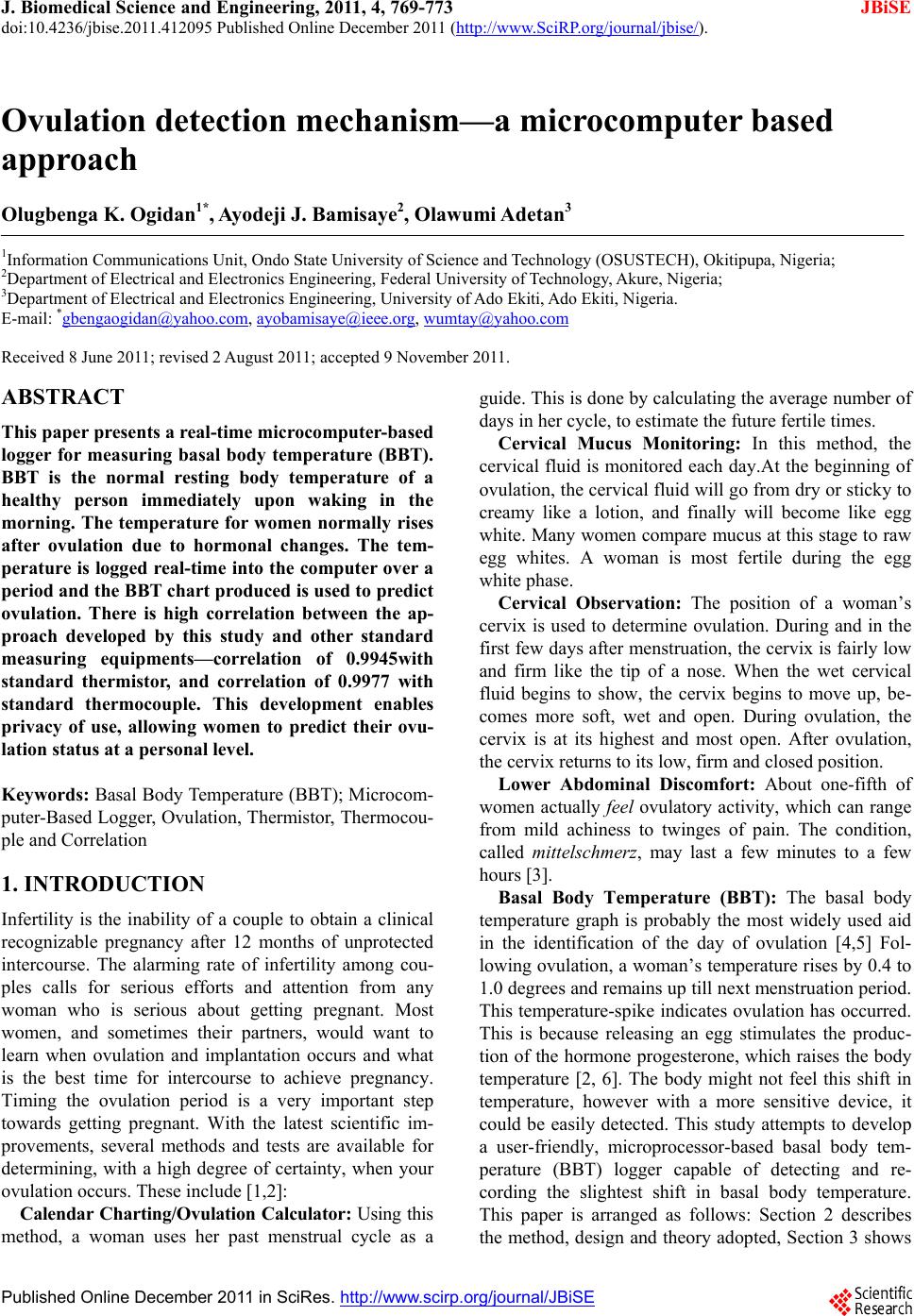
J. Biomedical Science and Engineering, 2011, 4, 769-773
doi:10.4236/jbise.2011.412095 Published Online December 2011 (http://www.SciRP.org/journal/jbise/ JBiSE
).
Published Online December 2011 in SciRes. http://www.scirp.org/journal/JBiSE
Ovulation detection mechanism—a microcomputer based
approach
Olugbenga K. Ogidan1*, Ayodeji J. Bamisaye2, Olawumi Adetan3
1Information Communications Unit, Ondo State University of Science and Technology (OSUSTECH), Okitipupa, Nigeria;
2Department of Electrical and Electronics Engineering, Federal University of Technology , Akure, Nigeria;
3Department of Electrical and Electronics Engineering, University of Ado Ekiti, Ado Ekiti, Nigeria.
E-mail: *gbengaogidan@yahoo.com, ayobamisaye@ieee.org, wumtay@yahoo.com
Received 8 June 2011; revised 2 August 2011; accepted 9 November 2011.
ABSTRACT
This paper presents a real-time microcomputer-based
logger for measuring basal body temperature (BBT).
BBT is the normal resting body temperature of a
healthy person immediately upon waking in the
morning. The temperature for women normally rises
after ovulation due to hormonal changes. The tem-
perature is logged real-time into the computer over a
period and the BBT chart produced is used to predict
ovulation. There is high correlation between the ap-
proach developed by this study and other standard
measuring equipments—correlation of 0.9945with
standard thermistor, and correlation of 0.9977 with
standard thermocouple. This development enables
privacy of use, allowing women to predict their ovu-
lation status at a personal level.
Keywords: Basal Body Temperature (BBT); Microcom-
puter-Based Logger, Ovulation, Thermistor, Thermocou-
ple and Correlation
1. INTRODUCTION
Infertility is the inability of a couple to obtain a clinical
recognizable pregnancy after 12 months of unprotected
intercourse. The alarming rate of infertility among cou-
ples calls for serious efforts and attention from any
woman who is serious about getting pregnant. Most
women, and sometimes their partners, would want to
learn when ovulation and implantation occurs and what
is the best time for intercourse to achieve pregnancy.
Timing the ovulation period is a very important step
towards getting pregnant. With the latest scientific im-
provements, several methods and tests are available for
determining, with a high degree of certainty, when your
ovulation occurs. These include [1,2]:
Calendar Charting/Ovulatio n Calculator: Using this
method, a woman uses her past menstrual cycle as a
guide. This is done by calculating the average number of
days in her cycle, to estimate the future fertile times.
Cervical Mucus Monitoring: In this method, the
cervical fluid is monitored each day.At the beginning of
ovulation, the cervical fluid will go fro m dry or stick y to
creamy like a lotion, and finally will become like egg
white. Many women compare mucus at this stage to raw
egg whites. A woman is most fertile during the egg
white phase.
Cervical Observation: The position of a woman’s
cervix is used to determine ovulation. During and in the
first few days after menstruation, the cervix is fairly low
and firm like the tip of a nose. When the wet cervical
fluid begins to show, the cervix begins to move up, be-
comes more soft, wet and open. During ovulation, the
cervix is at its highest and most open. After ovulation,
the cervix returns to its low, firm and closed position.
Lower Abdominal Discomfort: About one-fifth of
women actually feel ovulatory activity, which can range
from mild achiness to twinges of pain. The condition,
called mittelschmerz, may last a few minutes to a few
hours [3].
Basal Body Temperature (BBT): The basal body
temperature graph is probably the most widely used aid
in the identification of the day of ovulation [4,5] Fol-
lowing ovulation, a woman’s temperature rises by 0.4 to
1.0 degrees and remains up till nex t menstruation p eriod.
This temperature-spike indicates ovulation has o ccurred.
This is because releasing an egg stimulates the produc-
tion of the hormone progesterone, which raises the body
temperature [2, 6]. The body might not feel this shift in
temperature, however with a more sensitive device, it
could be easily detected. This study attempts to develop
a user-friendly, microprocessor-based basal body tem-
perature (BBT) logger capable of detecting and re-
cording the slightest shift in basal body temperature.
This paper is arranged as follows: Section 2 describes
the method, design and theory adopted, Section 3 shows